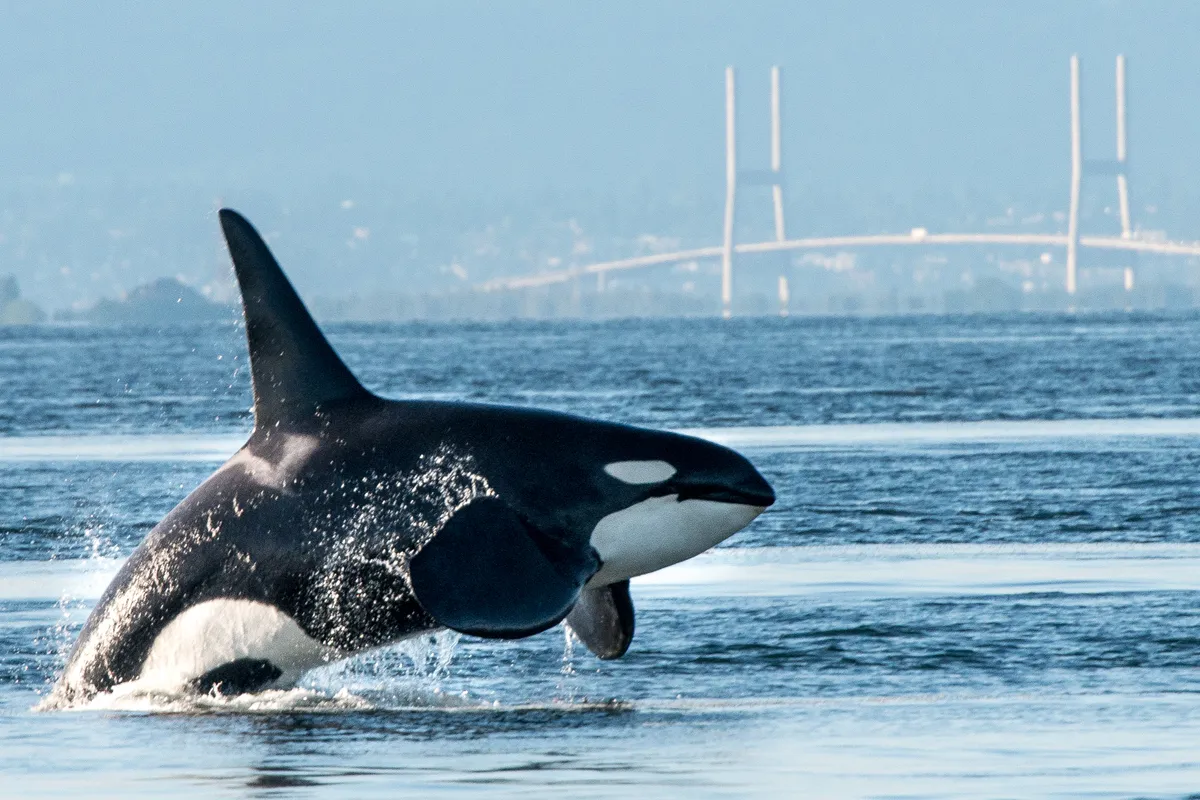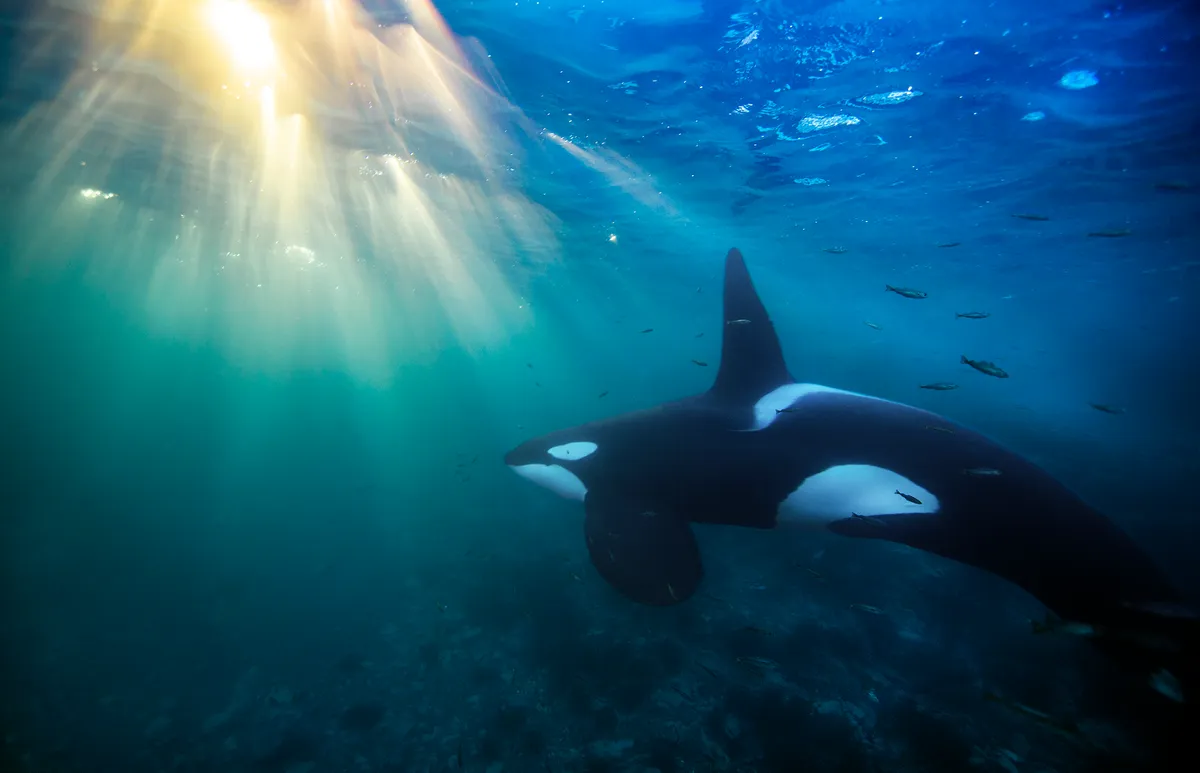What does an orca look like?
Orcas have a distinctive appearance, a large black body, a white underside, a white patch above and behind the eye, ‘saddle patch’ behind the dorsal fin.

Are orcas dolphins or whales?
Despite being called killer whales, orcas actually belong to the dolphin family Delphinidae. They're the only species in their genus, but their closest relatives are dolphin species from around Australia and South East Asia like the Irrawaddy dolphin.
So orcas are dolphins not whales.

Why are orcas sometimes called killer whales?
We don't really know where killer whales got their name from. One theory is that they were called 'killers of whales' by whalers in the past, and the name became corrupted into 'killer whales' over time.
The Latin name for orca or killer whale is Orcinus orca. Orcinus translates to “of the kingdom of the dead” and is probably derived from Roman God of the underworld Orcus, a reference to the fierce hunting reputation of this animal.
How much does an orca weigh?
A newborn baby orca weighs as much as a motorbike at about 180kg, and they're 2-3m long. An adult male can weigh about 8600kg and grow up to 10m in length, while an adult female can weigh about 5400kg and grow up to 9m in length.

Where do orcas live?
Orcas lives in every ocean and range from the Arctic to the Antarctic, while also living in the tropical waters in between. While their populations have been significantly reduced, orcas are only absent from the Black Sea and the Baltic Sea, as well as some areas of the Arctic Ocean.
Please note that external videos may contain ads:
What do orcas eat?
Orcas have separated into two ecotypes (a distinct form or race of a animal species occupying a particular habitat). Northeastern Pacific residents are fish-eaters whereas their transient counterparts eat mostly marine mammals for example. Orcas residing in waters off New Zealand have even been known to eat sharks and rays.

Do orcas eat dolphins?
Orcas will eat other species of dolphin, although they're harder to catch than some other prey because they can swim so quickly. In a high-speed chase, it's not easy for a killer whale to open its mouth due to the drag it would cause on its lower jaw, so orcas will typically ram dolphins to stun them before going in for the kill.

How fast can orca swim?
Thanks to their large size and huge power, orcas are very fast swimmers and have been recorded at speeds of up to 54km/h (33mph).

Do orcas have predators?
Orcas are apex predators, which means they're at the very top of the food chain and they have no predators. Killer whales are some of the largest and most powerful animals in the ocean, and no other predator is able to challenge them.

How do orcas hunt?
Herding fish before stunning them with tail strikes is one of many ways in which these predators hunt their prey. As highly intelligent predators, orcas also work together in coordinated attacks to create waves that can knock prey off floating ice into the water.
Orcas have even learned the dangerous trick of beaching themselves to catch sea lions in Patagonia before wriggling back into the water.
Please note that external videos may contain ads:
Do orcas attack humans?
There's only been a single report of a wild orca attacking a human, and that may well have been a case of mistaken identity as the person attacked was surfing at the time. We don't know why orcas don't generally attack people, but one theory is that wetsuits make us effectively invisible to a ocra's sonar thanks to the insulating nitrogen bubbles in the material.
Orcas behave very differently in captivity, and orca attacks on humans have occurred in zoos and aquariums. A orca called Tilikum, kept at Sea World for 25 years, was involved in the deaths of three people on separate occasions.
Please note that external videos may contain ads:
How do orcas sleep while swimming?
Cetaceans, including orcas, have the ability to rest one side of their brain at time. This allows the side that’s awake to regulate breathing and prevents drowning, while the other side takes a nap.

What is a group of orcas called?
A group of orcas is known as a pod. A pod of orcas usually consists of a mature female, her adult offspring, and her daughters’ offspring. Female orcas beyond breeding age will help to guide and care for young members of the pod.
How do orcas communicate?
In the ocean orcas rely on using clicks and whistles to exchange information with the rest of the pod. At the surface they have been known to use body language to communicate, including breaching, slapping their flippers or tail, and "spyhopping" (bringing their head out of the water).

How long can orcas live?
Female orcas have a significantly longer lifespan than males, despite the fact that they undergo menopause, so they can live for decades after they can no longer reproduce.
In the wild, female orcas live for an average of 50 years, while the average for males is just 29 years. Much older individuals have been recorded, with some females reaching 80 years or more. One orca was thought to have been 105 years old at the time of her death, but this could not be verified.
How much do social ties matter for orcas? Author of Furry Logic Liz Kalaugher explains...

Very much. In fact, for a male living off the Pacific north-west coast of North America, social standing can be a matter of life and death.
In years when populations of Chinook salmon are low (numbers can drop as a result of El Niño-driven temperature fluctuations and increased fishing activity), the mortality rate of the males nearest the centre of their social networks is 67 per cent lower than that of their least connected counterparts. Males on the social sidelines may be unaware of the whereabouts of their salmon prey, and could be excluded from shared meals, making them more likely to starve in leaner times.
A female’s social position, in contrast, doesn’t alter her chances of survival.